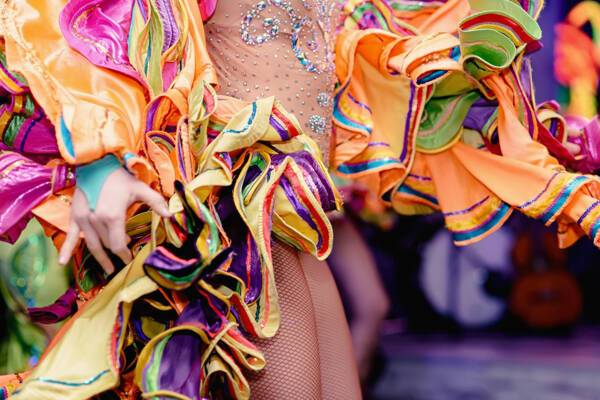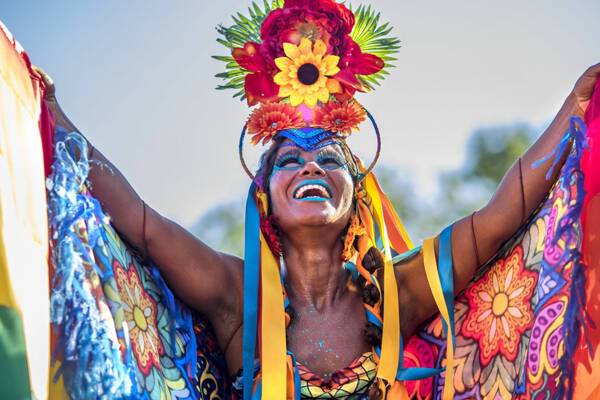Call us FREE 0808 2394 989
Opening Hours - Office closed, we'll open at 8:30am
Call us FREE 0808 2394 989
Opening Hours - Office closed, we'll open at 8:30am

Experience the glitz and glamour of the world’s biggest party
Published on 14 Apr 2022
Rio de Janeiro is one of the brightest and liveliest cities in the world. And, when its annual carnival rolls around, everyone hits the streets to celebrate. From the dazzling, colourful costumes and awe-inspiring floats of the Samba Parade to the vibrant street parties filled with euphoric party-goers and lively samba bands, Rio Carnival really is out of this world. Here’s everything you need to know about Rio Carnival:

Today, Rio Carnival attracts over 6 million participants. Each day, there are more than 2 million on the streets during festivities. With roughly 1.5 million tourists joining in with the celebrations each year, it’s thought that the carnival brings in a whopping 2.5 billion Brazilian Real (£5 million) in tourism revenue.
Officially, the carnival runs from Friday night to noon on Ash Wednesday (which can fall anywhere between 4th February and 10th March). But that doesn’t stop locals and tourists from partying from as early as January! The celebrations officially kick-off when the mayor of Rio de Janeiro hands over the keys to the city to King Momo, a mythical figure said to lead the festivities.
“Rio Carnival is a fun and unique cultural experience,” Dan and Bailey from Destinationless Travel explain. “Nowhere else in the world will you see such vibrant costumes, large street parties and friendly people? From the exquisite costumes to the fired-up atmosphere, there really is nowhere better to party! It’s no wonder Rio Carnival is registered as the biggest carnival in the world in the Guinness World Records.
“The entire city of Rio de Janeiro during carnival is electric. Almost all of the locals get time off work which means it is time to party - and Brazilians sure can party! Walking through the streets of Rio, you’re sure to find revellers dancing and celebrating in true Brazilian style, colourful fancy dress costumes in every direction and a wealth of pop-up bars, shops and food stalls.” But where did the carnival originate?

Dating as far back as the 17th century, Rio Carnival is a Catholic event by origin, although it is also thought to be rooted in European pagan traditions too. According to The Culture Trip, the Portuguese word ‘carnaval’ is derived from the Latin ‘carne vale,’ which translates to ‘goodbye flesh,’ as the carnival was originally a food festival ending on Ash Wednesday - the start of Lent and the 40 days of deprivation that followed.
The carnival is said to be the result of a cultural clash between Portugal and Africa, starting with the Portuguese bringing the festival with them from Europe after colonising Brazil in the early 17th century. Grand balls and parties were held only for the elite Portuguese but soon, Afro-Brazilians decided to hold parties of their own, playing African-inspired music and wearing fancy dresses to mock the formal dress of the elite.
The two celebrations stayed separate for many years until the turn of the 20th century when the parties took to the streets. The festival was now an annual party with musical styles and dancing merging over time. In 1917, this traditional dancing and music style was officially coined ‘samba’ and has been a core part of Brazil’s musical heritage ever since.
Carnival was being celebrated all over Brazil but it was in Rio where the carnival we all know today started to take shape as the first samba schools were formed in the early 1920s. By the 1930s, samba schools were starting to compete with the addition of parades and floats in a bid to be crowned the carnival winners.

When wandering around the streets of Rio de Janeiro during carnival you’re sure to stumble upon a street party. Also known as ‘blocos,’ street parties are organised and planned by dedicated groups, some of which have been around for several decades.
Each bloco has a theme and writes a unique theme song for its samba band to play. Themes can range from wild and wacky to casual and family-orientated. Anyone is welcome to join in with a street party’s festivities but deciding which one to join can be a tough choice. Although each bloco can draw in a fair crowed, the largest is the Cordão Da Bola Preta (Big Cord of the Black Ball) which takes place in the city centre on the Saturday of carnival, drawing in about one million eager party-goers.
“At any one given time, you’ll find at least one bloco where you can join in on the fun,” says Bailey. “Blocos often involve live music, dancing, dressing up and of course, some drinking!” Five days (or sometimes more) of partying is thirsty work, so much so that Brazilian drinks giant AMBEV estimates that 1.8 billion gallons of alcohol are sold throughout the carnival.
If you’re hoping to look as fabulous as the locals, Rafaela from local Rio tour group Strawberry Tours recommends heading into the city centre. “Buy your carnival costume at the popular market located in the city centre. This is part of the tradition and with little money, it is possible to buy a nice costume and have fun with the locals. Glitter is mandatory! Prepare to shine during the five days of partying.”
Here, Rafaela tells us about her favourite street parties:
Looking to get involved with Brazil’s samba culture? Rafaela recommends attending Cordão do Boitatá (Cord of the Boitatá). “Cordão do Boitatá was founded by both students and musicians in 1996 and can be found on the Praça XV square, in the centre of Rio. Even though it was not part of the official bloco program of the city, Boitatá was responsible for the revitalisation of the street carnival in Rio. Every year the bloco’s incredible performances attract thousands of people, which last for seven hours and are always held on Sunday.”
Are you a lover of comic books and superheroes? Then his bloco is for you! “The super fun Desliga da Justiça (Justice Cut off) is superhero themed, even the musicians dress in superhero clothes! Get ready to see Batman, Wolverine, Wonder Woman and so many other comic book characters getting the crowd into the carnival spirit. The bloco is baked in a pleasant plaza in the neighbourhood of Gávea and it is very usual to see parents taking their children to performances.”
Love The Beatles? Then Sargento Pimenta (which translates to ‘Sergeant Pepper,’) should be at the top of your street party list. “For those who think that Rio carnival is restricted to samba, make no mistake! One of the most popular blocks in the city, Sargento Pimenta was founded in 2011 by fans of The Beatles. The bloco plays the biggest hits of the British band in carnival rhythm and draws in a huge crowd of Beatles fans that love to passionately sing along. Wear your mask of John Lennon, hire a yellow submarine and party the night away!”

One of the main events of the carnival is the highly-anticipated Samba Parade which is held in the city’s Sambadrome arena. “The Sambadrome is another place to find electric energy during carnival,” Bailey explains. “This is the official samba competition. It goes on over several nights and is a ticketed event showcasing thousands of dancers all performing in extraordinary costumes.”
The competition is made up of 12 samba schools that practice all year to be crowned the winners of the carnival. Each school spends up to $4 million on outfits and preparations, with a total of 3,000 dancers, musicians and float operators. Most of those that take part in the parade are from local communities such as the favelas (slums), with each school presenting a different theme to entertain the 72,000 spectators in the arena (not counting those watching on television!)
Becky from Global Grasshopper told us, “Brazil’s most famous parade is a glitter-filled whirlwind of euphoria and there’s nothing else quite like it in the world. When the day finally arrives, the dancers adorn themselves with truly mind-blowing and brilliantly colourful costumes. I think everyone should go at least once in their lifetime as it’s one of those travel bucket list events, especially for people who love to travel and experience other cultures. Dance, have fun and lose yourself in the music.”

As well as partying, Claire from Tales of a Backpacker advised us how to eat and drink like a true Brazilian: “Brazilian food is delicious and varied. During Rio Carnival, street food is king as everyone is outside joining the parties. You’ll find street stalls selling barbecued meats, pão de queijo (delicious balls of cheesy bread), pastels (deep-fried pastries) or empanadas (pies) which are filled with meat, cheese or shrimp. My favourites are coxinha (teardrop-shaped dumplings filled with shredded chicken) or bolinho de bacalhau (fried codfish balls).”
If you’d like to sit and enjoy a traditional Brazilian dish at a restaurant, Claire recommends booking ahead. “You may need to reserve a table, as Rio is busiest during this time of year. The city has some amazing restaurants and you can enjoy the all-you-can-eat Brazilian barbecues (rodizio), feijoada (black bean and meat stew) and moqueca seafood stew as well as plenty of regional Brazilian specialities. You can also find international restaurants of all types, including plenty of sushi which is very popular in Rio.”

Rio Carnival is the perfect excuse to let your hair down and dance the night away. But there are some safety tips to consider. Rafaela tells us how to keep safe during the celebrations while enjoying yourself to the max:
“February and March are very hot and humid months with average temperatures of 35 degrees celsius. Drink lots of water, coconut water or isotonic. The heat is strong, the party is good and we often forget the fundamental: hydration.”
Unfortunately, Rio Carnival is a great target for petty crime. Rafaela recommends that you, “only bring a few accessories with you and, preferably, use belt bags for safekeeping. If you need to bring documents, take a copy with you and leave the original on the ship.”
“Wear lightweight and comfortable clothes and sneakers and make sure you protect yourself from the sun with caps/hats and sunscreens. In Rio de Janeiro, during the summer, the sun rises at 6 a.m. and only sets at 8 p.m.”
As you can’t verify your drinks will be safe, Rafael says to “avoid buying drinks such as caipirinhas or other drinks made with cachaça or vodka from street vendors. If you are buying something on the street, you may prefer pre-bottled drinks such as mineral water, beer or soft drinks.” Or if you’re able to, bring your own in a plastic bottle. Thank you for your tips, Rafaela!